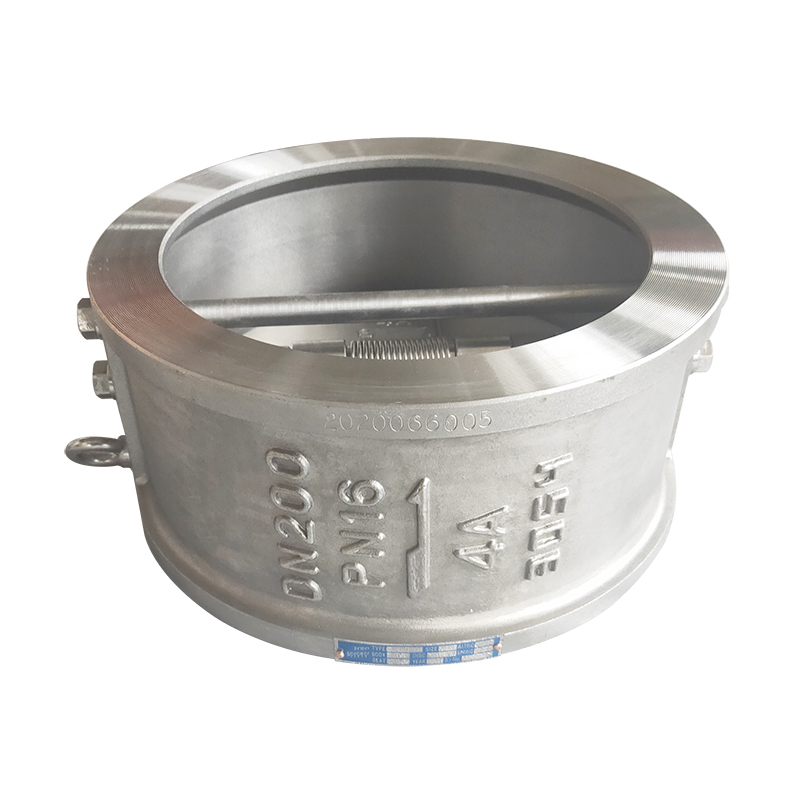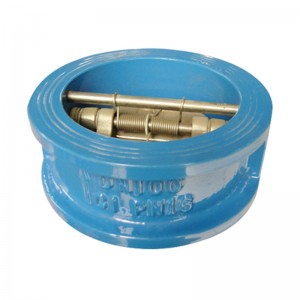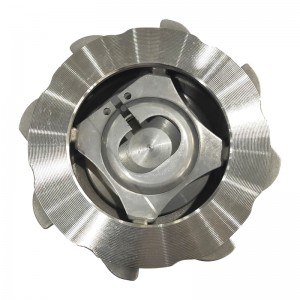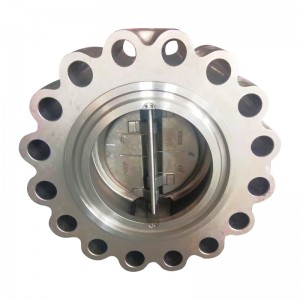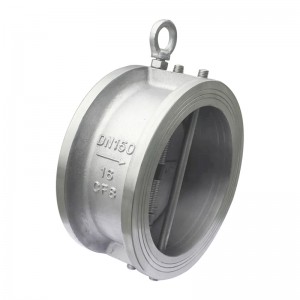API 594 Check Valve
Check Valve Technical Parameters
PRODUCT RANGE:
Sizes: NPS 2 to NPS 48
Pressure Range: Class 150 to Class 2500
End Connection: Wafer, RF, FF, RTJ
MATERIALS:
Casting: Cast Iron, Ductile Iron, A216 WCB, A351 CF3, CF8, CF3M, CF8M, A995 4A, 5A, A352 LCB, LCC, LC2, Monel, Inconel, Hastelloy,UB6, Bronze, C95800
STANDARD
| Design & manufacture | API594 |
| Face-to-face | ASME B16.10,EN 558-1 |
| End Connection | ASME B16.5, ASME B16.47, MSS SP-44 (NPS 22 Only) |
| Test & inspection | API 598 |
| Fire safe design | / |
| Also available per | NACE MR-0175, NACE MR-0103, ISO 15848 |
| Other | PMI, UT, RT, PT, MT |
Design Features:
1. Dual Plate or Single Plate
2. Wafer, Lug and Flanged
3. Retainless and Retain
API 594 Dual plate check valve is used for pure pipelines and industrial, environmental protection, water treatment, water supply and drainage pipelines in high-rise buildings to prevent the reverse flow of media. The check valve adopts a wafer type, the butterfly plate is two semicircles, and adopts a spring to force the reset, the sealing surface can be the body surfacing welding wear-resistant material or rubber lining, the use range is wide, and the sealing is reliable.
The opening and closing parts of API 594 check valve rely on the flow and force of the medium to open or close by themselves to prevent the medium from flowing back. The valve is called the check valve. Check valves belong to the category of automatic valves, which are mainly used in pipelines where the medium flows in one direction, and only allow the medium to flow in one direction to prevent accidents.
According to the structure of the check valve, it can be divided into three types: lift check valve, swing check valve and wafer check valve. Lift check valves can be divided into two types: vertical and horizontal. Swing check valves are divided into three types: single valve, double valve and multi valve. The wafer check valve is a straight-through type. A check valve is a valve that can automatically prevent fluid from flowing back. The valve flap of the check valve opens under the action of fluid pressure, and the fluid flows from the inlet side to the outlet side. When the pressure on the inlet side is lower than that on the outlet side, the valve flap is automatically closed under the action of the fluid pressure difference, gravity and other factors to prevent the fluid from flowing back.
If you need more details about valves please contact NSW(newsway valve) sales department
Professional knowledge of API 594 check valves
What is the API 594 Standard
API 594, established by the American Petroleum Institute (API), is the definitive industry standard titled “Check Valves: Flanged, Lug, Wafer, and Butt-welding Types.” This critical specification governs the design, material selection, structural dimensions, pressure-temperature tolerance, and inspection/testing protocols for industrial check valves.
Scope & Application of API 594
API 594 applies to both Type A (short face-to-face) and Type B (long face-to-face) check valves. It comprehensively covers various structural designs, including:
- Swing Check Valves
- Lift Check Valves
- Dual Plate Check Valve /Wafer Check Valves
- Butterfly Check Valves
The standard is applicable for valve sizes ranging from DN 150 (NPS 6) to DN 400 (NPS 16). It governs valves constructed from materials like gray cast iron, ductile iron, carbon steel, stainless steel, and other alloys.
API 594 Design & Material Requirements
- Design Compliance: Valve design must strictly adhere to API 594 specifications.
- Connection Standards: End connections (flanged, lug, wafer, butt-weld) must conform to dimensions and ratings outlined in referenced standards like ASME B16.11 (Socket Welding & Threaded) and ASME B16.15 (Cast Bronze Threaded Fittings – Class 125 & 250).
- Material Selection: Permitted body materials include gray cast iron, ductile iron, carbon steel, stainless steel, and various alloys. Crucially, the sealing surface material must be compatible with the specific service medium to ensure integrity and prevent corrosion or degradation.
Valve Structure & Connection Methods
API 594 categorizes valves based on their end connections:
- Flanged Type: Utilizes flanged ends for bolted connection to piping flanges. Ideal for standard flange piping systems requiring easy assembly/disassembly.
- Butt-Weld Type: Features beveled ends for direct welding to the pipeline. Designed for high-temperature, high-pressure, or critical service applications where leak-tight integrity is paramount.
- Lug Type: Incorporates threaded inserts (lugs) on the valve body, enabling installation between flanges using bolts through the lugs, suitable for dead-end service.
- Wafer Type: Offers a compact, lightweight design installed between flanges using long bolts spanning the entire pipeline. Space-efficient for industrial piping systems.
Pressure-Temperature Ratings
API 594 rigorously defines the pressure-temperature (P-T) ratings for check valves based on material, design, and size. These ratings guarantee the valve can operate safely and reliably under specified temperature and pressure conditions throughout its service life. Designers and operators must strictly adhere to these P-T limits.
Inspection & Testing Requirements
All API 594 check valves undergo mandatory inspection and testing to verify performance and integrity. Testing protocols strictly follow industry standards, primarily:
- API 598: Valve Inspection and Testing (covers shell tests, seat tests, backseat tests, etc.).
- ASME B16.10: Face-to-Face and End-to-End Dimensions of Valves.
Key tests include: - Shell Strength Test: Verifies the pressure-containing body and bonnet integrity.
- Seat Leakage Test: Confirms the sealing capability of the closure mechanism.
- High-Pressure Closure Test: Ensures sealing under rated pressure.
- Low-Pressure Closure Test: Ensures sealing under minimal pressure.
- Backseat Test (if applicable): Validates stem sealing under pressure when the valve is fully open.
Newsway Valves Materials
The China Valve Manufacturer from China, its valves body and trim material can be offered in Forged type and Casting type. Next to Stainless Steel and Carbon Steel material, we also manufacture valves in special materials such as titanium, nickel alloys, HASTELLOY®*, INCOLOY®, MONEL®, Alloy 20, super-duplex, corrosion resistant alloys and urea grade materials.
Available Valve Materials
| Tradename | UNS nr. | Werkstoff nr. | Forging | Casting |
| Carbon steel | K30504 | 1.0402 | A105 | A216 WCB |
| Carbon steel | 1.046 | A105N | ||
| Low Temp Carbon steel | K03011 | 1.0508 | A350 LF2 | A352 LCB |
| High Yield steel | K03014 | A694 F60 | ||
| 3 1/2 Nickel steel | K32025 | 1.5639 | A350 LF3 | A352 LC3 |
| 5 Chrome, 1/2 Moly | K41545 | 1.7362 | A182 F5 | A217 C5 |
| 1 1/4 Chrome, 1/2 Moly | K11572 | 1.7733 | A182 F11 | A217 WC6 |
| K11597 | 1.7335 | |||
| 2 1/4 Chrome, 1/2 Moly | K21590 | 1.738 | A182 F22 | A217 WC9 |
| 9 Chrome, 1 Moly | K90941 | 1.7386 | A182 F9 | A217 CW6 |
| X 12 Chrome, 091 Moly | K91560 | 1.4903 | A182 F91 | A217 C12 |
| 13 Chrome | S41000 | A182 F6A | A351 CA15 | |
| 17-4PH | S17400 | 1.4542 | A564 630 | |
| 254 SMo | S31254 | 1.4547 | A182 F44 | A351 CK3MCuN |
| 304 | S30400 | 1.4301 | A182 F304 | A351 CF8 |
| 304L | S30403 | 1.4306 | A182 F304L | A351 CF3 |
| 310S | S31008 | 1.4845 | A182 F310S | A351 CK20 |
| 316 | S31600 | 1.4401 | A182 F316 | A351 CF8M |
| S31600 | 1.4436 | |||
| 316L | S31603 | 1.4404 | A182 F316L | A351 CF3M |
| 316Ti | S31635 | 1.4571 | A182 F316Ti | |
| 317L | S31703 | 1.4438 | A182 F317L | A351CG8M |
| 321 | S32100 | 1.4541 | A182 F321 | |
| 321H | S32109 | 1.4878 | A182 F321H | |
| 347 | S34700 | 1.455 | A182 F347 | A351 CF8C |
| 347H | S34709 | 1.4961 | A182 F347H | |
| 410 | S41000 | 1.4006 | A182 F410 | |
| 904L | N08904 | 1.4539 | A182 F904L | |
| Carpenter 20 | N08020 | 2.466 | B462 N08020 | A351 CN7M |
| Duplex 4462 | S31803 | 1.4462 | A182 F51 | A890 Gr 4A |
| SAF 2507 | S32750 | 1.4469 | A182 F53 | A890 Gr 6A |
| Zeron 100 | S32760 | 1.4501 | A182 F55 | A351 GR CD3MWCuN |
| Ferralium® 255 | S32550 | 1.4507 | A182 F61 | |
| Nicrofer 5923 hMo | N06059 | 2.4605 | B462 N06059 | |
| Nickel 200 | N02200 | 2.4066 | B564 N02200 | |
| Nickel 201 | N02201 | 2.4068 | B564 N02201 | |
| Monel® 400 | N04400 | 2.436 | B564 N04400 | A494 M35-1 |
| Monel® K500 | N05500 | 2.4375 | B865 N05500 | |
| Incoloy® 800 | N08800 | 1.4876 | B564 N08800 | |
| Incoloy® 800H | N08810 | 1.4958 | B564 N08810 | |
| Incoloy® 800HT | N08811 | 1.4959 | B564 N08811 | |
| Incoloy® 825 | N08825 | 2.4858 | B564 N08825 | |
| Inconel® 600 | N06600 | 2.4816 | B564 N06600 | A494 CY40 |
| Inconel® 625 | N06625 | 2.4856 | B564 N06625 | A494 CW 6MC |
| Hastelloy® B2 | N10665 | 2.4617 | B564 N10665 | A494 N 12MV |
| Hastelloy® B3 | N10675 | 2.46 | B564 N10675 | |
| Hastelloy® C22 | N06022 | 2.4602 | B574 N06022 | A494 CX2MW |
| Hastelloy® C276 | N10276 | 2.4819 | B564 N10276 | |
| Hastelloy® C4 | N06455 | 2.461 | B574 N06455 | |
| Titanium GR. 1 | R50250 | 3.7025 | B381 F1 | B367 C1 |
| Titanium GR. 2 | R50400 | 3.7035 | B381 F2 | B367 C2 |
| Titanium GR. 3 | R50550 | 3.7055 | B381 F3 | B367 C3 |
| Titanium GR. 5 | R56400 | 3.7165 | B381 F5 | B367 C5 |
| Titanium GR. 7 | R52400 | 3.7235 | B381 F7 | B367 C7 |
| Titanium GR. 12 | R53400 | 3.7225 | B381 F12 | B367 C12 |
| Zirconium® 702 | R60702 | B493 R60702 | ||
| Zirconium® 705 | R60705 | B493 R60705 |







